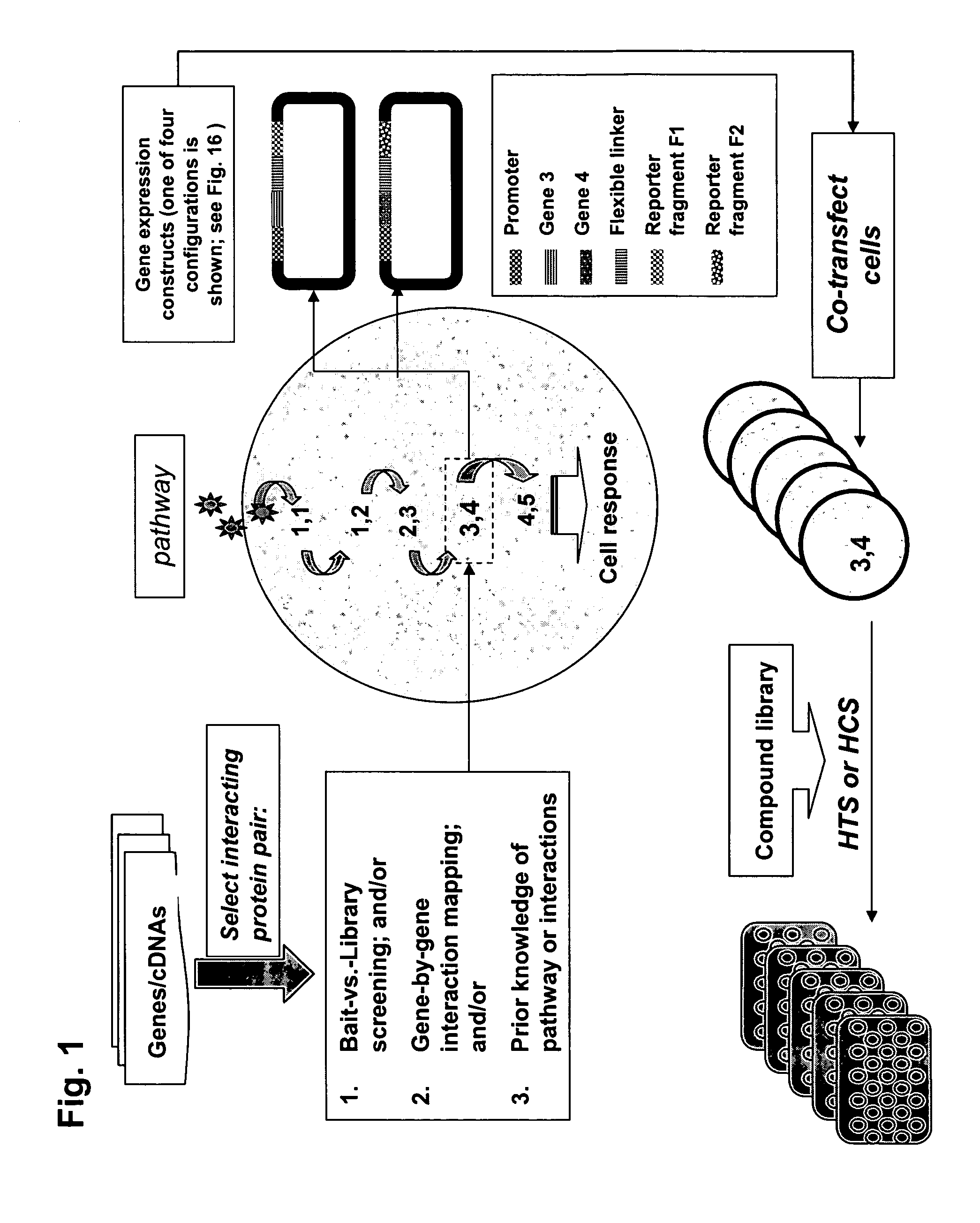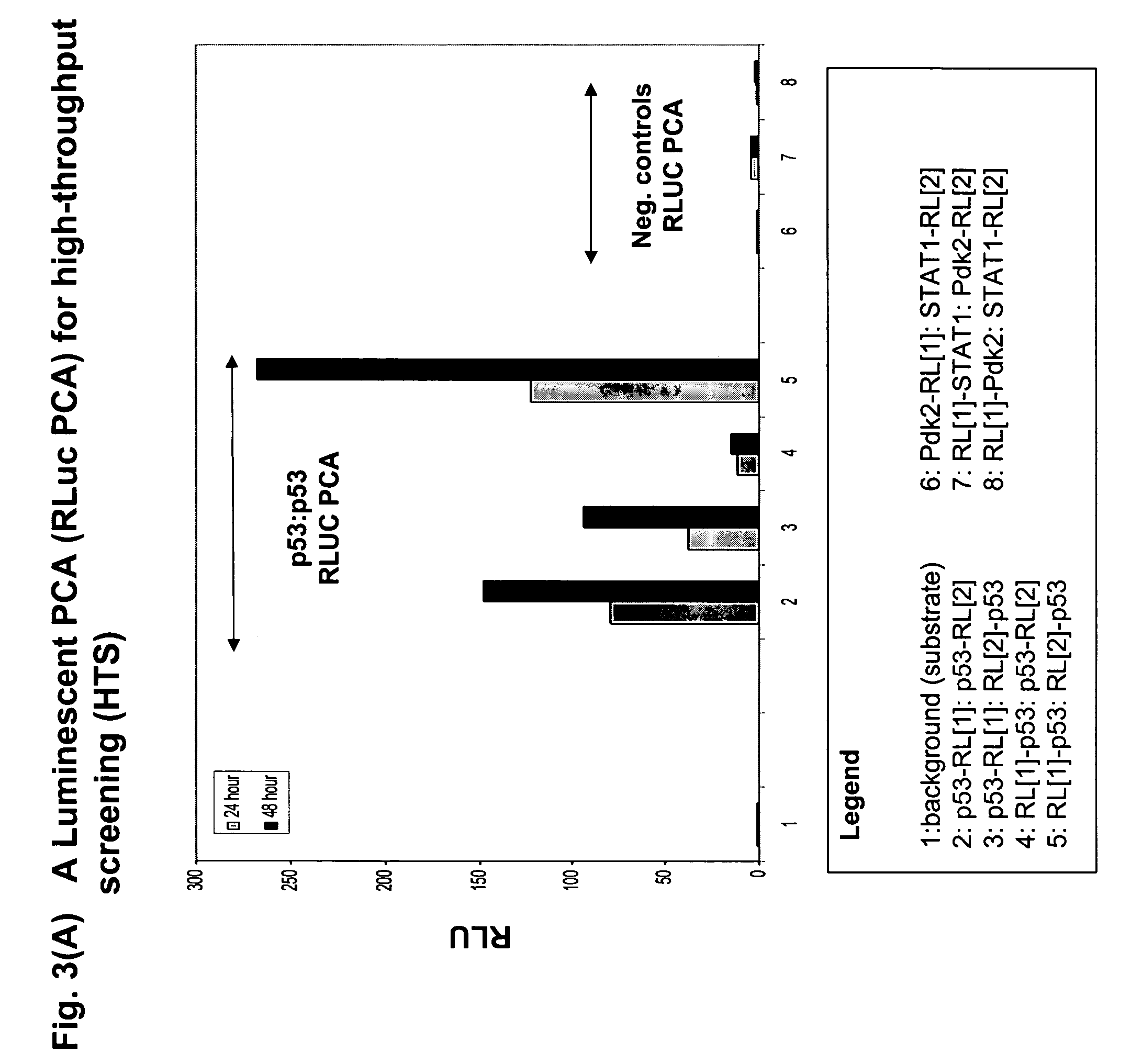Protein fragment complementation assays for high-throughput and high-content screening
- Summary
- Abstract
- Description
- Claims
- Application Information
AI Technical Summary
Benefits of technology
Problems solved by technology
Method used
Image
Examples
example 1
Fluorescent and Luminescent Assays for HTS and HCS
[0143]In the first example of the present invention, we sought to demonstrate the construction of a wide range of useful assays based on fluorescent and luminescent PCAs and to demonstrate their use for high-throughput and high-content assays in conjunction with standard HTS and HCS instrumentation. We used elements of the DNA damage response pathway.
[0144]FIG. 2 shows a scheme of the pathway and the results for an HTS assay based on a beta-lactamase PCA (BLA PCA) and a HCS assay based on a GFP PCA. FIG. 3 shows an HTS assay based on Renilla luciferase (RLuc PCA). FIG. 4 shows a high-content assay based on an IFP PCA (IFP is a variant of GFP). In these examples, the proteins assayed are interacting pairs in the DNA damage response pathway, specifically, the checkpoint kinase Chk1 which interacts with the tumor suppressor p53 (Chk1 / p53 PCA), or p53 itself which forms homodimers (p53 / p53 PCA).
[0145]For the BLA PCA, the genes of interes...
example 2
Identifying Novel Protein-protein Interactions and Constructing Quantitative Assays
[0195]The PCA strategy described in the invention and depicted in FIG. 1 was next used to identify novel protein-protein interactions in the PI-3-kinase and PKA / PKC-mediated pathways and then to carry out quantitative screens based on the novel interactions. First, cDNA library screening was performed with the GFP PCA in order to identify proteins interacting with PKB. A novel interaction between PKB and Ft1 was identified by the GFP PCA screen. Subsequently, the GFP PCA was used to construct fluorescent assays for PKB / Ft1 and PDK1 / Ft1. The organization of the pathways and the position of the PKB / hFt1 interaction is shown in FIG. 5(A). Methods for library screening with PCA and for assay construction are provided below.
[0196]DNA Constructs. The full-length cDNAs encoding PKB, PDK1, PKCalpha, the catalytic subunit of PKA (PKAc), GSK3beta, BAD, Caspase 9 and FKHRL1 were amplified by PCR and subcloned in...
example 3
High-throughput Assays with YFP PCA
[0201]We next sought to demonstrate that PCAs can be used as quantitative assays providing relevant pharmacological information. For the example we used the well-characterized interaction of FKBP (the FK506 binding protein) and its cognate partner, FRAP (FKBP-Rapamycin-Associated-Protein), an interaction that occurs only at a low level in untreated cells but which is markedly induced by the immunosuppressant drug, rapamycin. The organization of the human growth pathway, showing the ‘sentinel’ FKBP / FRAP interaction, is depicted in FIG. 6A.
[0202]For these studies, we used a YFP PCA. HEK 293E Cells were seeded into a 96 well plates at a cell density of 13,000 per well. Cell media is MEM-alpha Growth medium. Total volume was 100 microliters. Cells were allowed to grow 20–24 hours prior to transfection—cells were 70–80% confluent at time of transfection. Cells were maintained at 37C, 5% CO2. Cells were transfected with a total of 0.1 micrograms of DNA p...
PUM
| Property | Measurement | Unit |
|---|---|---|
| Flexibility | aaaaa | aaaaa |
| Content | aaaaa | aaaaa |
Abstract
Description
Claims
Application Information
 Login to View More
Login to View More - R&D
- Intellectual Property
- Life Sciences
- Materials
- Tech Scout
- Unparalleled Data Quality
- Higher Quality Content
- 60% Fewer Hallucinations
Browse by: Latest US Patents, China's latest patents, Technical Efficacy Thesaurus, Application Domain, Technology Topic, Popular Technical Reports.
© 2025 PatSnap. All rights reserved.Legal|Privacy policy|Modern Slavery Act Transparency Statement|Sitemap|About US| Contact US: help@patsnap.com



